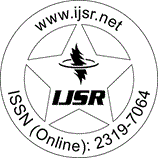Downloads: 136
India | Microbiology | Volume 7 Issue 3, March 2018 | Pages: 1793 - 1798
Production of Biopigment ?Prodigiosin? from Serratia Marcescens under Optimized Conditions
Abstract: Prodigiosin, a Biopigment, is a secondary metabolite that is a natural red colored pigment which belongs to the family prodiginines. It has a tripyrrole in its structure and is produced by many strains of bacterium Serratia marcescens and other gram negative and some unrelated organisms. Prodigiosin has a variety of biological activities such as antimicrobial, antifungal, antioxidant, antitumor, antimalarial, antiproliferative and immunosuppressive activity and also has wide application in textile, printing, food, cosmetic and therapeutic industries. Therefore, the present study was aimed to screen different natural samples (soil, water and surface swab) for isolation of the prodigiosin producing Serratia marcescens. Isolates were identified by standard microbiological procedures and production of pigment was carried out on Nutrient broth. Extraction was carried out using acidified methanol and subjected to spectrum scanning in range between 300-700nm using methanol as blank followed by Presumptive test to confirm pigment as Prodigiosin. Various parameters were optimized for highest pigment production. Pigment was used to check Bioemulsification activity, Antioxidant activity, Antimicrobial activity and Antibiofouling activity. In the current study, highest pigmented bacterial isolate obtained from the effluent sample and thus was used for pigment production, extraction and further study. The highest absorption peak was observed at 534nm using methanol as blank and pigment production was found to influence by various condition that used for optimization.
Keywords: Antimicrobial, Microbial pigments, Optimization, Prodigiosin, Serratia marcescens
How to Cite?: Hariyali H. Sorathiya, Dr. Manisha Shah, "Production of Biopigment ?Prodigiosin? from Serratia Marcescens under Optimized Conditions", Volume 7 Issue 3, March 2018, International Journal of Science and Research (IJSR), Pages: 1793-1798, https://www.ijsr.net/getabstract.php?paperid=ART20181157, DOI: https://dx.doi.org/10.21275/ART20181157
